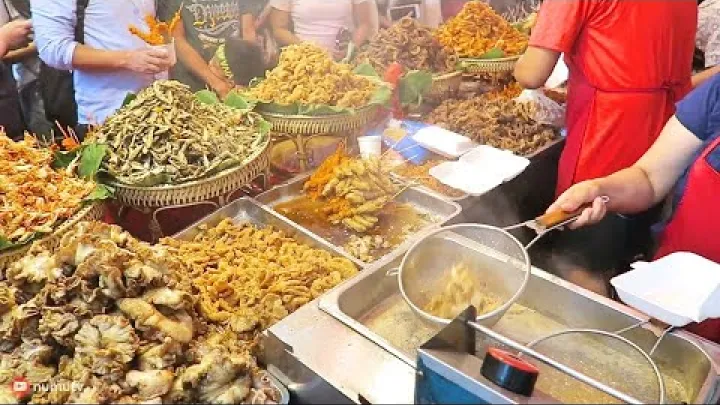Savor the Flavors: Exploring the Authentic Delights of Filipino Cuisine
Embark on a culinary adventure as we delve into the mouthwatering realm of Filipino cuisine, renowned for its authenticity, abundance of flavors, and cultural significance. From fiery adobo to savory sinigang, Filipino dishes go beyond mere sustenance to offer a truly immersive and sensory experience.
Drawing inspiration from a diverse range of influences, including indigenous flavors, Spanish colonization, and Asian traditions, Filipino cuisine is a vibrant tapestry of taste. Each dish tells a story, weaving together history, tradition, and local ingredients to create something truly unique.
In this article, we'll take you on a tantalizing journey, exploring the authentic delights of Filipino cuisine and uncovering the secrets behind its rich tapestry of flavors. From the iconic pork belly dish, lechon, to the comforting warmth of halo-halo, we'll introduce you to the must-try dishes that will make your taste buds dance with delight.
So, get ready to savor the flavors and embark on a gastronomic journey through the rich and diverse landscape of Filipino cuisine. Whether you're a seasoned foodie or a curious traveler, prepare to be enchanted by the charm, complexity, and sheer deliciousness that is Filipino cooking.
The Unique Flavors of Filipino Cuisine
Filipino cuisine is a melting pot of flavors, combining influences from various cultures and regions. The combination of sweet, sour, and savory flavors creates a harmonious balance that is uniquely Filipino. Each dish is a symphony of taste, with ingredients carefully selected to create a burst of flavors in every bite.
One of the defining characteristics of Filipino cuisine is the abundant use of spices and aromatics. Ingredients such as garlic, onions, ginger, and lemongrass are commonly used to add depth and complexity to dishes. These flavors, combined with the use of vinegar, soy sauce, and various citrus fruits, create a distinct tanginess that is often associated with Filipino cooking.
Filipino cuisine also showcases a wide variety of textures, from the crispy skin of lechon to the tender meat of adobo. The use of different cooking techniques, such as grilling, braising, and stewing, adds depth and dimension to the dishes. Whether it's the crunchy lumpia or the velvety smoothness of leche flan, Filipino cuisine offers a textural experience that is sure to delight the senses.
A Brief History of Filipino Cuisine
Filipino cuisine is deeply rooted in the country's history and culture. Its origins can be traced back to pre-colonial times, when indigenous tribes relied on locally available ingredients for sustenance. The arrival of Spanish colonizers in the 16th century brought new flavors and ingredients, such as tomatoes, potatoes, and various spices, which were incorporated into traditional Filipino dishes.
The Chinese traders who settled in the Philippines also left a lasting influence on Filipino cuisine. They introduced noodles, soy sauce, and other Chinese ingredients, which are now staples in Filipino cooking. In more recent years, Filipino cuisine has also been influenced by American fast food chains, resulting in a unique fusion of flavors.
Despite these influences, Filipino cuisine has managed to maintain its distinct identity. It continues to embrace its indigenous roots, with dishes like sinigang, kare-kare, and pinakbet, which highlight the use of local vegetables, herbs, and spices. Filipino cuisine is a testament to the country's rich history and cultural heritage.
Popular Filipino Dishes
No exploration of Filipino cuisine would be complete without sampling some of its most popular dishes. These iconic dishes are a reflection of the country's diverse culinary heritage and are beloved by Filipinos and foreigners alike.
One such dish is adobo, often considered the national dish of the Philippines. Adobo is a savory stew made with meat, usually pork or chicken, marinated in vinegar, soy sauce, garlic, and spices. The meat is then braised until tender, resulting in a flavorful dish that pairs well with rice.
Another beloved dish is sinigang, a comforting soup made with tamarind as its base. Sinigang can be made with various meats, such as pork, beef, or fish, and is typically loaded with vegetables like tomatoes, onions, and leafy greens. The tangy and sour flavors of sinigang make it a favorite among Filipinos, especially during rainy days.
Lechon, a whole roasted pig, is a centerpiece of Filipino celebrations and gatherings. The pig is marinated with a mixture of spices, herbs, and aromatics before being slowly cooked over an open fire. The result is a crispy skin and tender meat that is juicy and flavorful.
These are just a few examples of the many delicious dishes that Filipino cuisine has to offer. Each region in the Philippines has its own specialties and variations, making the culinary landscape even more diverse and exciting.
Regional Specialties in Filipino Cuisine
Filipino cuisine is not only diverse in flavors but also in regional specialties. Each region in the Philippines has its own unique dishes and cooking techniques, influenced by the local ingredients and cultural traditions.
In the northern part of the Philippines, the region of Ilocos is known for its bagnet, a crispy deep-fried pork belly. The pork belly is first boiled, then deep-fried until the skin becomes crispy and golden brown. It is often served with a vinegar-based dipping sauce and paired with steamed rice.
Moving to the central part of the country, the Visayas region offers a variety of seafood dishes. Cebu, in particular, is famous for its lechon, which is considered one of the best in the country. The pigs used for lechon in Cebu are often stuffed with a mixture of spices and herbs, giving it a distinct flavor.
In the southern part of the Philippines, the region of Mindanao showcases dishes with a strong Muslim influence. One such dish is piaparan, a chicken curry made with turmeric, ginger, and coconut milk. It is often served with rice and is known for its vibrant yellow color and rich flavors.
These are just a few examples of the regional specialties that can be found in Filipino cuisine. Exploring the different regions of the Philippines is like embarking on a gastronomic adventure, discovering new flavors and culinary traditions along the way.
Traditional Cooking Techniques in Filipino Cuisine
One of the things that sets Filipino cuisine apart is its traditional cooking techniques, which have been passed down through generations. These techniques not only enhance the flavors of the dishes but also showcase the resourcefulness and ingenuity of Filipino cooks.
One traditional cooking technique is the use of banana leaves as a wrapper or lining for dishes. This technique is commonly used in dishes like suman, a sticky rice cake wrapped in banana leaves, and inihaw na isda, grilled fish wrapped in banana leaves. The banana leaves impart a subtle aroma to the dish, enhancing its overall flavor.
Another traditional cooking technique is the use of a palayok, a clay pot, for slow cooking. This technique is often used for dishes like sinigang and adobo, allowing the flavors to develop slowly over time. The clay pot retains heat well and distributes it evenly, resulting in tender meat and flavorful broths.
Filipino cuisine also makes use of fermentation as a preservation method and flavor enhancer. One example is bagoong, a fermented shrimp paste that is used as a condiment or ingredient in various Filipino dishes. The fermentation process gives bagoong a unique umami flavor that adds depth to dishes like kare-kare and binagoongan.
These traditional cooking techniques not only contribute to the flavors of Filipino dishes but also showcase the cultural heritage and resourcefulness of the Filipino people.
Filipino Street Food
No exploration of Filipino cuisine would be complete without a mention of its vibrant street food culture. Filipino street food offers a wide array of flavors and textures, perfect for those looking for a quick and delicious snack.
One popular street food is isaw, grilled chicken or pork intestines skewered on bamboo sticks. The intestines are cleaned, marinated, and then grilled over charcoal, resulting in a smoky and flavorful snack. Isaw is often served with a vinegar-based dipping sauce and is a favorite among locals.
Another street food favorite is fish balls, deep-fried fish balls served with a sweet and spicy sauce. Fish balls are made from a mixture of fish meat, flour, and spices, then deep-fried until golden brown. They are often sold by street vendors and can be enjoyed on the go.
Other popular street food items include kwek-kwek, deep-fried quail eggs coated in orange batter, and balut, a fertilized duck egg that is boiled and eaten as a delicacy. Filipino street food offers a unique and exciting culinary experience, showcasing the creativity and ingenuity of Filipino street vendors.
Famous Filipino Desserts
Filipino cuisine is not just about savory dishes; it also boasts a wide variety of delectable desserts. Filipino desserts are known for their rich flavors, unique textures, and vibrant colors, making them a feast for both the eyes and the taste buds.
One famous Filipino dessert is halo-halo, which translates to "mix-mix" in English. Halo-halo is a refreshing dessert made with a combination of crushed ice, sweetened fruits, jellies, beans, and topped with a scoop of ube (purple yam) ice cream. It is often enjoyed during hot summer months and is a favorite among Filipinos.
Another popular dessert is leche flan, a creamy caramel custard made with eggs, condensed milk, and sugar. The custard is steamed until set and then chilled before serving. Leche flan is often served during special occasions and is a staple in Filipino celebrations.
Bibingka and puto bumbong are two traditional Filipino desserts often enjoyed during the Christmas season. Bibingka is a rice cake made with rice flour, coconut milk, and eggs, while puto bumbong is a sticky purple rice cake steamed in bamboo tubes. These desserts are often paired with hot chocolate and are a delightful treat during the holiday season.
Filipino desserts offer a sweet ending to any meal and are a testament to the creativity and artistry of Filipino pastry chefs and home cooks.
Filipino Food Festivals and Events
Filipino cuisine is celebrated throughout the year in various food festivals and events across the country. These festivals showcase the diversity and richness of Filipino food, allowing visitors to immerse themselves in the vibrant culinary culture of the Philippines.
One such festival is the Pahiyas Festival held in Lucban, Quezon. The festival is a colorful celebration of the harvest season, with houses adorned with colorful rice decorations and fruits. Local delicacies like kakanin (rice cakes) and longganisa (sausages) are also showcased during the festival, giving visitors a taste of the local cuisine.
The Kadayawan Festival in Davao City is another food festival that celebrates the abundance of fruits and agricultural products in the region. The festival features a variety of food stalls, offering a wide selection of dishes made with local ingredients. Visitors can sample durian, pomelo, and other tropical fruits, as well as traditional dishes like sinuglaw (grilled pork belly and fish ceviche) and kinilaw (raw fish marinated in vinegar).
These food festivals and events not only highlight the flavors and culinary traditions of the Philippines but also provide a platform for local farmers, producers, and chefs to showcase their products and skills.
Conclusion: Embrace the Rich Flavors of Filipino Cuisine
Filipino cuisine is a treasure trove of flavors, traditions, and cultural heritage. From the humble adobo to the festive lechon, Filipino dishes offer a sensory experience that is sure to delight and satisfy. The rich tapestry of flavors, the use of local ingredients, and the ingenuity of Filipino cooks all contribute to the uniqueness of Filipino cuisine.
So, next time you find yourself craving something new and exciting, why not give Filipino cuisine a try? Explore the diverse regional specialties, indulge in street food delights, and savor the sweetness of Filipino desserts. Embark on a gastronomic journey through the rich and diverse landscape of Filipino cuisine, and let your taste buds dance with delight.
Your Nearby Location
Your Favorite
Post content
All posting is Free of charge and registration is Not required.



